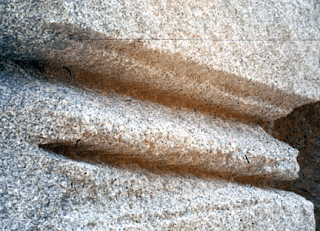As was mentioned at the beginning, the main way in waterjets remove concrete most efficiently is by washing out the cement around the individual particles of the aggregate, which, in turn, causes the particles to fall out of the slot, since they are no longer supported.
If a cutting head is built with the jets pointing vertically downwards, so that, as the head moves, so the jets spin over the surface and wash out the cement over a wider path, any cement that underlies a particle is not removed, and the particle remains held in place by the underlying cement column.
Regardless of how the nozzle is moved over the surface, with only vertical jets the path of the assembly very rapidly becomes blocked, and the nozzles can no longer move into the slot to deepen it.
The obvious solution to this is to incline the nozzles so that as they rotate over the surface, they can reach under individual particles and wash out the cement beneath them, removing their support. This also has the advantage of cutting a path into the concrete that is wider than the cutting head itself, so that on later passes the head can be lowered into the cut, shortening the standoff distance to the fresh surface and improving cutting efficiency.
Moving the head down a little on each pass also has the advantage that it exposes fresh layers of cement to the jet action and makes it more likely that all the cement within the desired slot is removed (and the aggregate with it) leaving a clear path for the assembly to move deeper into the slot.
So the question then arises as to what the most efficient angle is to tilt the nozzles to, relative to the perpendicular axis of the target surface. (I use that awkward phrase because not all targets are going to be flat horizontal bridge or garage decks).
Very shallow angles don’t work very well. The best demonstration of this was when we started cutting slots in granite, with an initial divergent jet angle of around 8 degrees. After the first few passes we noted that the slot was developing walls that sloped into the cut. As a result the slot was getting narrower with depth, and the nozzle assembly would no longer be able to move into the cut.


Figure 1. Tapering cut into granite. The nozzle had been advanced about a third of an inch after each pass of a dual-nozzle rotating head. Nevertheless the cut tapered as the cutting continued.
We had chosen that initial angle because it worked well when cutting slots in coal, but clearly in harder, less jointed material that was not the case. And so we, and others, have carried out tests to find out what the best angle would be for the cutting tests.
And, before I show the results, let me emphasize that these only hold true for a certain concrete mix. Where aggregate particle sizes are larger, the jet angle may need to change to make it easier to get around. The pattern of the jets on the surface, (affected by the ratio of the rotation speed of the head relative to the movement of the entire assembly over the surface) and the jet parameters themselves (jet pressure, nozzle diameter and standoff distance) also play a part. In this latter regard remember that the effective range for many waterjet streams is not that much more than a hundred diameters from the orifice, so that expecting some of the smaller nozzle sizes (say 0.005 inches) to cut cement more than half-an-inch from the nozzle may be an exercise in futility – and raising the jet pressure in that circumstance is unlikely to fix the fact that the target is simply out of range.
So, with those caveats, here is the result that was obtained by Puchala, Lechem and Hawrylewicz*:


Figure 2. The effect of nozzle angle on cutting performance in removing concrete (*Puchala, R.J., Lechem, A.S., and Hawrylewicz, B.M., “Mass Concrete Removal by High Pressure Waterjet,” Paper 22, 8th International Symposium on Jet Cutting Technology, Durham, UK. September, 1986, pp. 219 – 229.)
Nevertheless it is clear that there is much better performance where the jets are inclined at an angle between 25 and 35 degrees to the normal to the target surface. This is reflected in the improved efficiency of cutting (as shown by the second line in figure 2, showing a more significant change with angle than is evident from the depth of cut measurements). In all cases we have found that the jet angle needs to be 15 degrees or greater to make sure that wall taper does not occur.
Correlating the rotation speed against the traverse speed of the head over the surface to find the optimal cutting performance is a little more difficult, and should generally be assessed for given concrete targets with a short test run, before the major effort is undertaken. One reason for this is the wide range in performance that can be found with different cements. We have worked with cement that was sufficiently weathered that it could almost be removed using one’s hands, on the one hand, and the new cements that contain silica fume, or small wires or fibers pose a different and more difficult challenge on the other.
This also holds true over setting the advance rate of the nozzle assembly into the slot after each pass (where the head is cutting in a series of passes to penetrate the slab). Here the advance is going to be controlled in part by the size of the aggregate, though it should be noted that even with little apparent progress the nozzle assembly should be advanced after each pass, since this exposed a fresh layer of cement to attack, and this will lead to more aggregate release and help in clearing the cut.



